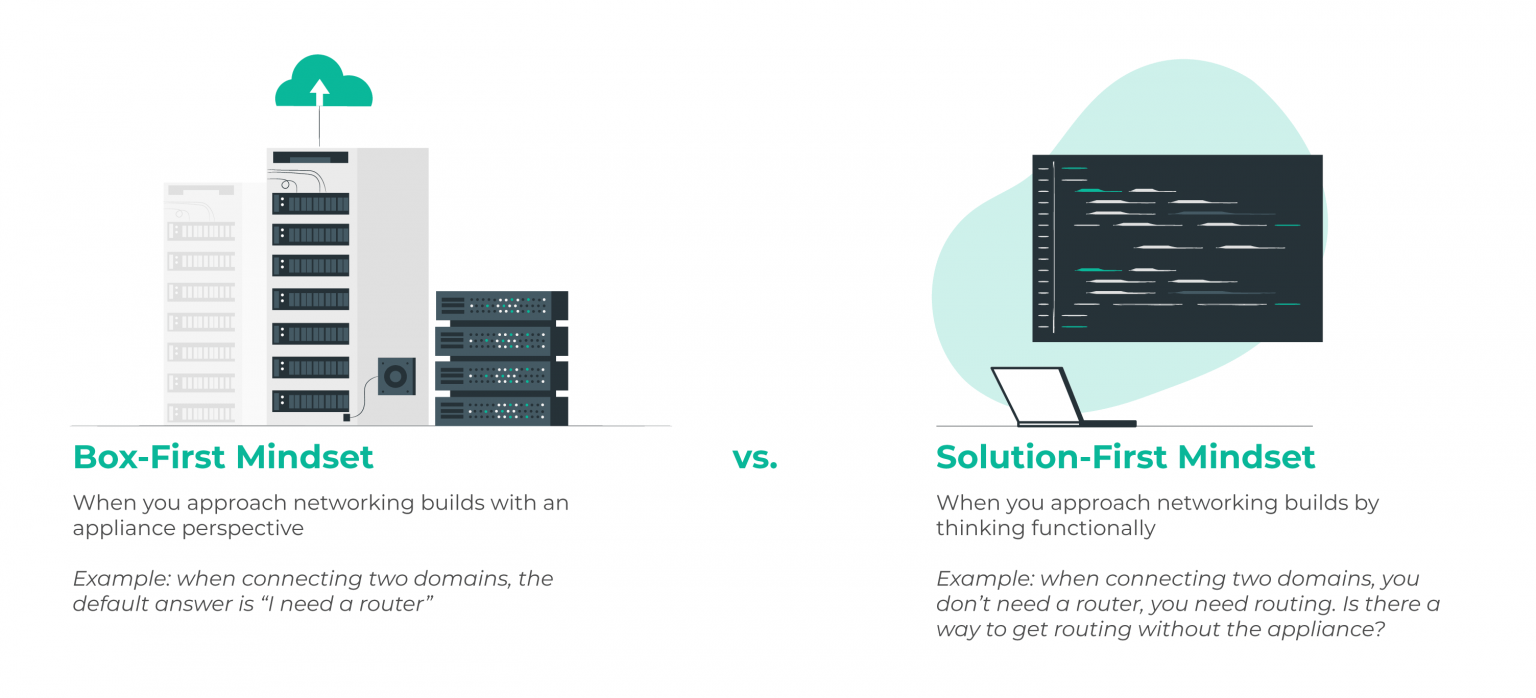Cloud Interconnections should be built in minutes. Today, however, it’s not unusual for it to take months to turn up a new direct cloud interconnection. The reason it often takes months to build a direct cloud interconnection is that most people construct them with a device-centric, “Box- First” mindset.
“Box-First” is what happens when you approach networking builds with an appliance perspective. For example “Box First” dictates that because you need to connect two different networking domains together you need to have a router. Instead, think functionally. You don’t need a router; you need routing. “Box-First” tells you that you need a firewall to build encrypted VPNs. You don’t need a firewall; you need IPsec. Even with NFV, you’re still dedicating boxes (even if they are servers) to deploys routers. Break out of the Box!

Building a direct cloud interconnection will require many network functions that are usually delivered via boxes. But you don’t have to build interconnections this way anymore.
How fast could you build a direct cloud interconnection?
If you didn’t get a chance to watch the video above, spoiler alert: we think it should take 34 seconds to build an interconnection using new methods – not the typical 47 days it takes when using an appliance-based approach.
The Opportunity Cost You Pay for Taking 47 Days to Build an Interconnection
Why do you need to build your cloud interconnections faster? It comes down to opportunity cost. We have all heard that we can save hundreds of thousands of dollars by moving workloads into the public cloud. Recently AWS released a great TCO tool that will show you exactly how much you could save. We plugged in a few hypothetical use cases and in some cases, the potential savings are astounding. Check it out, you may discover that moving some workloads to the public cloud could save your organization a lot of money.
But, one of the things the AWS TCO savings tool doesn’t show you is the opportunity cost you’re going to pay because of the time it will take to build the cloud interconnection required to access your workloads running in the public cloud.
A “Real” Life Scenario
As more companies expand their work from home policies, more companies are moving their workloads to the cloud. Here’s an example of what the opportunity cost of this move ends up being when relying on a “Box-First” mindset.
The Situation
Let’s assume you’re moving workloads running in an on-site datacenter for a mid-sized company into the public cloud. See example #2 here. You want to set up a direct cloud interconnection rather than relying on the internet in order to maintain the same level of performance your employees are already experiencing. We can also assume you already have WAN connectivity to your office but you need to increase the access speed to accommodate the bandwidth needed for the new public cloud applications as well as to allow your employees to have improved remote access. According to the AWS calculator, you could save as much as $200,000 per year by making this change. Sounds pretty good, right?
The Likely Outcome and Opportunity Cost of Using “Box-First”
Ok, here’s where “Box First” steps in and corners you into a dark place. First, you do the math, find the savings and sell it to your CIO who says, “That’s great news! Go get me that $200K and I’ll get you a big promotion!” Woot! Easy money! You go tell your partner that the promotion is on the way and to start planning that Caribbean trip you’ve been dreaming about. You get the project rolling only to discover that you need to build a new cloud interconnection. No problem, you think. Your “Box-First” mindset leads the way. You reach out to your favorite box vendors because they know just what to do. And that’s when the darkness creeps in.
Suddenly, you find yourself inside the box and instead of getting that direct cloud interconnection built in a few days, it takes six weeks! Instead of saving $200K, your organization only sees $160K in savings.
What happened to the other $40K? You lost it in the time it took you to get the interconnection built. So instead of your boss giving you virtual high fives, she’s stuck on calls with the CEO explaining why the project that was supposed to save $200K only achieved $160K in savings… And sadly your promotion is gone, and there’s no tanning on a Caribbean island in your near future. That’s the opportunity cost.

Don’t let opportunity cost cheat you out of that promotion you deserve! Building a cloud interconnection should take minutes not weeks and you should demand more from your vendors and your service providers.
The moral of the story is to learn how to break out of the “Box-First” mindset and start thinking with a “Solutions-First” mindset so you can start packing for your Caribbean vacation instead.


